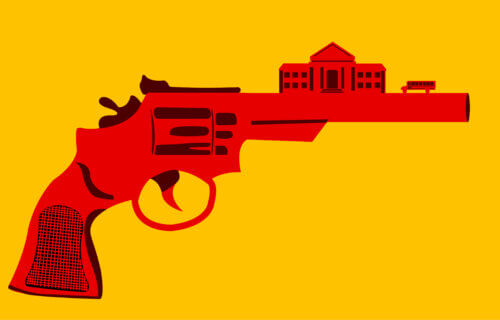NEW YORK — America has societal issues with both mental health and gun violence, but mass shooting incidents apparently have less to do with mental illness than many might think. Researchers from Columbia University found that most school shootings involve shooters with no history of psychosis. Their study could help to debunk the myth that people who are mentally ill are also prone to violence.
“Our findings suggest that mass school shootings are different from other forms of mass murder and that they should be looked at as a distinct phenomenon,” says Ragy R. Girgis, the director of the Center of Prevention and Evaluation at Columbia/NYSPI, specializing in the study and treatment of young adults at high risk for schizophrenia and other psychoses, in a statement. “To prevent future mass school shootings, we need to begin to focus on the cultural and social drivers of these types of events, such as the romanticization of guns and gun violence, rather than on individual predictors.”
The study was the largest analysis of mass school shootings to date. Researchers looked at data collected from the Columbia Mass Murder Database to find a possible relationship between mental illness and mass shootings. They searched through 14,785 murders between 1900 and 2019 and narrowed it down to 82 incidents that took place in an academic setting. These included schools, colleges, and universities within or outside the U.S.
Nearly half (47.6%) of school shootings occurred in the United States, most involving semi or fully-automatic firearms. All of the school shooters were men with an average age of 28. Two-thirds (66.7%) were Caucasian.

Psychotic disorders such as schizophrenia were not observed among most of the shooters. Psychotic symptoms were more often seen among mass murder suspects who used weapons other than firearms. Roughly half (45.6%) of the mass casualty events ended with the perpetrators taking their own lives. The study authors suggest that the killers likely view their actions and their suicide as a “final act.”
“The findings strongly suggest that focusing on mental illness, particularly psychotic illness, when talking about mass school shootings risks is missing other factors that contribute to the vast majority of cases, as well as exacerbating the already widespread stigma surrounding severe mental illness,” explains Paul Appelbaum, an Elizabeth K. Dollard Professor of Psychiatry, Medicine and Law at Columbia University and co-author of the study.
Although researchers say their data won’t be able to identify who could potentially be future school shooters, it gives lawmakers and law enforcement a better profile of how mass school shootings differ from other acts of violence.
The study is published in the Journal of Forensic Sciences.

Fully automatic arms? In a nation which requires strict government oversight of such ownership? Balderdash. I stopped reading at that point, the author obviously offering up unfounded gossip and anti gun rethoric as fact. I challenge the author to offer evidence that any school shooter, in a case of national prominence has used a fully automatic firearm in their crime in the United States. Until then, all else in this article or by the author on this subject must be read as being highly factual suspect.
That’s true, but does it matter with semi-automatic weapons, bump-stocks and huge bullet clips? One could argue that a shooter would be less accurate with a fully-automatic gun than a semi-automatic tricked out weapon.
Why would a school shooting need to be of “national prominence” before you would consider the use of a fully automatic firearm to be worthy of your consideration?
I am a retired school counselor who worked for 11 years in an elementary school in Capitol Heights, MD. While those years took me thru 2007, I remain connected to some of those students and in contact with and working with school and law personnel in Prince Georges County to find solutions to the behaviors your study includes. I have drawn another conclusion after doing – admittedly not lengthy but coupled with my very direct exposure to the students who fit the following profile…enough to lead me to a tentative conclusion – that school shooters are most often those who suffered significant and persistent bullying through out their school years; that their shootings were often long planned; that they were about revenge. These overlooked and under served students as they grew – were easy enough to remember when others reflected on how they were bullied; that little if anything was done to help them. There are bully prevention programs in the schools but there simply are not enough counselors or, worse, enough time in any school day to follow thru with the attention these bullied students need. Often they become quiet and isolated and, because they are not the disruptive ones, they don’t stand out and, thus, don’t get the immediate attention the others get. I sincerely believe this aspect needs consideration as folks/entities such as yourselves dedicate time to. Thank you for listening!
Forty million people in this country
are prescribed psychotropic drugs by a physician.
Mental illness is not a prerequisite.
The drugs come with a warning that they can cause
suicidal or homicidal ideation.
A disproportionate number of shooters fall in this category.